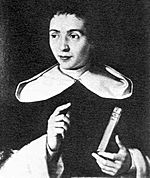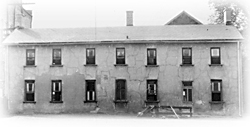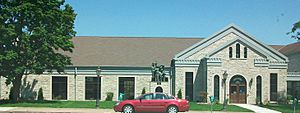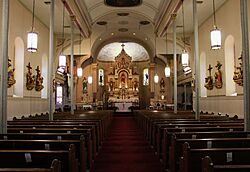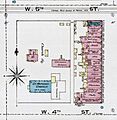St. Anthony's Catholic Church (Davenport, Iowa) facts for kids
|
St. Anthony's Roman Catholic
Church Complex |
|
|
U.S. Historic district
Contributing property |
|
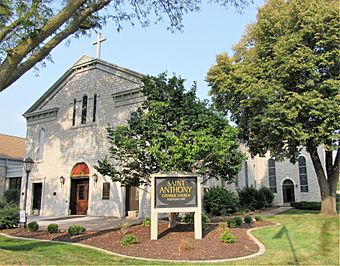
St. Anthony's Church in 2018
|
|
| Location | 407 and 417 Main St. Davenport, Iowa |
|---|---|
| Area | 1.4 acres (0.57 ha) |
| Built | 1838, 1853 |
| Built by | Thomas Doyle Henry Belken |
| Architect | Multiple |
| Architectural style | Greek Revival |
| Part of | Davenport Downtown Commercial Historic District (ID100005546) |
| MPS | Davenport MRA |
| NRHP reference No. | 84001538 |
Quick facts for kids Significant dates |
|
| Added to NRHP | April 5, 1984 |
St. Anthony's Catholic Church is a historic church community, called a parish, in downtown Davenport, Iowa. It is located at the corner of Fourth and Main Streets. St. Anthony's was the very first church group started in the city of Davenport. It was also the second Catholic church group in all of Iowa.
The church's buildings are so important that they are listed on the National Register of Historic Places. This listing includes the main church and the original church building, which was later used as a school. This original building is the oldest church building still standing in Iowa. The area has been known for a long time as Church Square.
Contents
How St. Anthony's Began
In 1832, the U.S. government and the Sauk tribe, led by Chief Keokuk, signed a treaty. This treaty opened up land on the west side of the Mississippi River for new settlers. Antoine LeClaire, who was part French and part Pottawattamie, served as the translator. For his help, he was given two large pieces of land.
When the city of Davenport was planned in 1836, LeClaire made a special request. He said that one of the town squares must be used for a Catholic church. In 1837, a priest named Rev. Samuel Charles Mazzuchelli arrived and started the church community. At the time, there were only 25 Catholics in a town of 100 people.
The First Church Building
Father Mazzuchelli designed a simple two-story building. It would be both a church and a home for the priest. He named the parish after two saints, St. Peter and St. Anthony of Padua. But because Antoine LeClaire's first name was Anthony, everyone started calling it St. Anthony's.
Construction began on April 27, 1838. The church was built for $2,000 using the very first bricks ever made in Davenport. The new church was officially opened on May 23, 1839. This small building was very important to the town. It was used as a church, a city hall, a courthouse, and a school. Its bell was rung for church services, to call children to school, and to warn people of fires.
The land, called Church Square, was given to the Catholic Church in 1839. Shops and other buildings were built on the property to earn money. This income helped Davenport become an important center for the church in 1881.
The First School in Davenport
St. Anthony's School opened in 1839, with the priest, Father Pelamourgues, as the teacher. Classes were held right inside the church. A curtain was used to separate the classroom area from the church's sanctuary. In 1844, the building was made larger to create a proper classroom.
One of the school's most famous students was John Forrest Dillon. He later became the Chief Justice of the Iowa Supreme Court.
In 1844, Father Pelamourgues invited a group of nuns, the Sisters of Charity of the Blessed Virgin Mary, to teach at the school. They returned in 1855 and also started a school for girls called the Immaculate Conception Academy. The nuns who taught at St. Anthony's lived at the academy. St. Anthony's parish school stayed open until 1968. Today, the building is still used for religious education classes.
A Growing Community
The church community grew quickly. By 1847, there were 450 members. In 1850, work began on the front part of the current church building. It was finished in 1853 and was built in a simple Greek Revival style using local stone. The original church building was then remodeled to have more classroom space.
As Davenport grew, other Catholic parishes were started.
- St. Joseph's (1855) was created for the German-speaking community.
- St. Margaret's (1856), later renamed Sacred Heart, became the main cathedral for the area.
- St. Mary's (1867) was started for English-speaking Catholics in the west end of town.
Even with these new churches, St. Anthony's kept growing. From 1885 to 1886, the church was made larger by adding wings on the sides, called transepts.
Changes Over Time
By the 1900s, St. Anthony's was the only church left in the downtown area. In the 1920s, a grotto, or small cave-like shrine, to the Blessed Virgin Mary was added on the north side of the church.
In the 1940s, the church complex got a new look. A manufactured stone covering called permastone was added to the 1886 addition, the school, and the priest's house (rectory). This made all the buildings look like they matched.
In the 1960s, changes were made inside the church for modern worship services. The communion rail was removed, and a new altar was added so the priest could face the people. However, the beautiful old altars, paintings, and statues were kept.
In 1987, the church celebrated its 150th anniversary. A special sculpture was placed out front. It shows Father Mazzuchelli, a nun, a child, Colonel George Davenport (who the city is named after), and Antoine LeClaire. The sculpture sits on top of a base that holds the church's original bell.
In 2009, most of the priest's house was removed to build a new parish center. The new building, called the Gathering Center, has classrooms, offices, a kitchen, and a large hall. It also has a space for "McAnthony's Window," a program that gives food to people in need. In 2017, a new pipe organ was installed in the church.
Helping the Community
From its earliest days, St. Anthony's has been active in the Davenport community. In the 1840s, a group that encouraged people to avoid alcohol held meetings there. The church also hosted public lectures and meetings for community groups.
Church leaders and members often spoke out against city rules they felt were harmful to the community. After World War II, the church became more involved in fighting for social justice, especially against unfair treatment based on race.
In August 1963, St. Anthony's was the starting point for the "March on Davenport." About 2,000 people marched to a park to show support for a law that would ensure fair housing for everyone in Iowa.
In 1985, the church started a "Care and Share" program. It sets aside 10% of the money collected each week to help people in need. A program called “McAnthony's Window” serves lunch to the homeless. The church also collects food for families at Thanksgiving, Christmas, and Easter.
A Look Inside and Out
St. Anthony's Church is built in the shape of a Latin Cross. The front part of the church is the oldest section and is made of limestone. It has a classic, simple design. The back part of the church was added later and is covered in permastone.
Inside, the church has a large central area, called a nave, with aisles on both sides. The ceiling is a high arch, and the windows are also arched. The beautiful stained glass windows are original to when each part of the church was built.
There are large paintings on the ceiling above the center aisle. They show stories from the Bible, such as Jesus raising Lazarus from the dead and the Assumption of Mary into Heaven. Statues of the Sacred Heart, Saint Patrick, and Saint John the Evangelist stand in the main altar area.
The original church building, which became the school, is a two-story building. It was originally made of brick but is now covered in permastone to match the main church. It has a simple design with a rounded arch over the entrance.
Images for kids
See also
- List of the oldest churches in the United States





